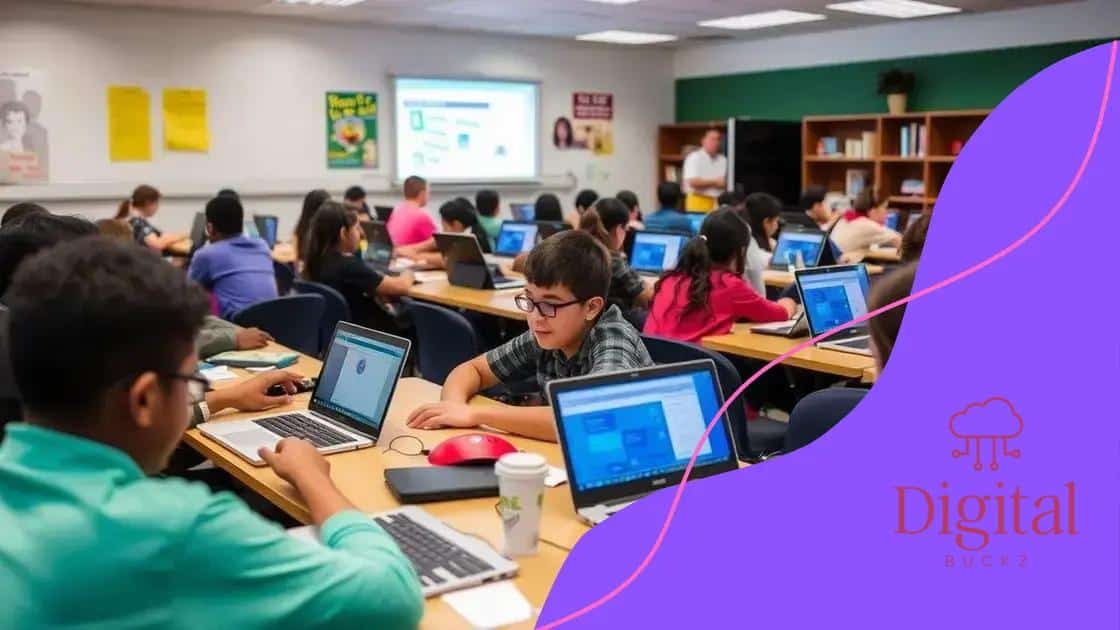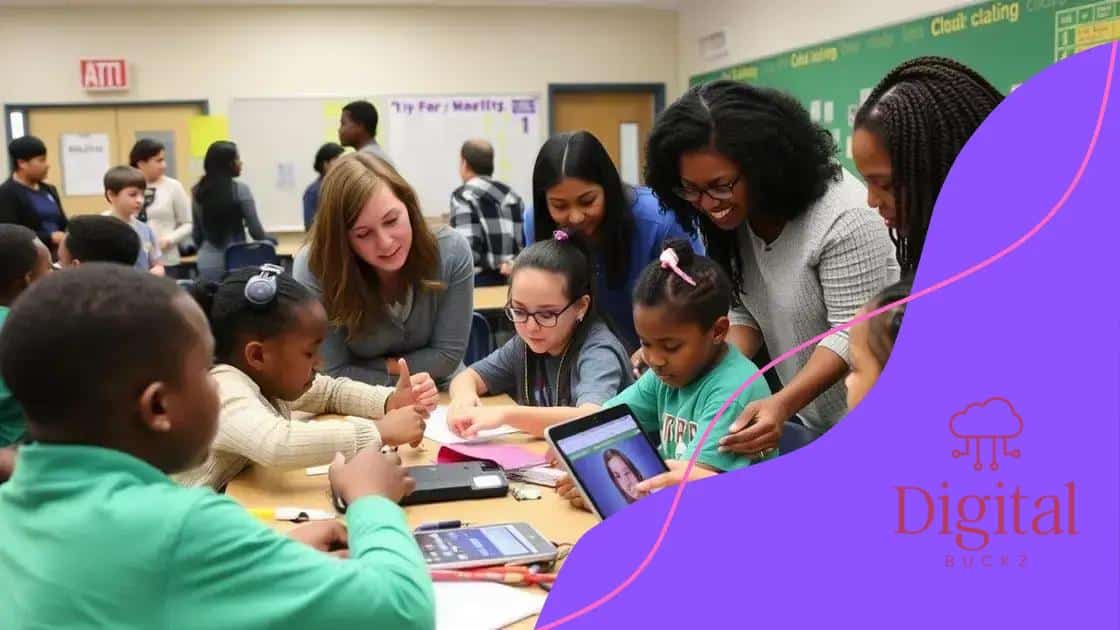Strategies to enhance digital literacy in schools

Strategies to enhance digital literacy in schools include integrating technology in the curriculum, engaging parents and the community, training educators, and assessing students’ digital skills to ensure they thrive in a technology-driven world.
Strategies to enhance digital literacy in schools are vital to equipping students with essential skills for today’s world. With technology woven into every aspect of life, have you considered how schools can effectively adapt? Let’s explore some impactful methods.
Understanding digital literacy basics
Understanding digital literacy basics is crucial for students today. As technology becomes a significant part of our daily lives, learning these skills starts early. Digital literacy includes the ability to find, evaluate, and communicate information using digital platforms. Teachers play a vital role in guiding students through this journey.
Key Components of Digital Literacy
To grasp the essentials, it is important to focus on several core components of digital literacy.
- Information Literacy: Knowing how to search for information online and assess its reliability.
- Communication Skills: Utilizing various digital tools to communicate effectively.
- Digital Etiquette: Understanding the proper behavior and expectations when interacting online.
- Online Safety: Recognizing the importance of secure and responsible internet usage.
These elements form the foundation of digital literacy. Students who master them not only improve their academic performance but also prepare for future careers. Additionally, schools must integrate technology into the curriculum to teach these skills effectively. Practical sessions using computers, tablets, and other devices help solidify students’ understanding of digital environments.
Fostering Digital Literacy
Educators can foster digital literacy by creating a supportive environment where students feel safe to explore. They can introduce collaborative projects that require careful online research or have students create presentations using digital tools. Meanwhile, parents can enhance these efforts by encouraging their children to engage in safe online practices and discuss their online experiences.
By working together, schools and families can ensure children gain the necessary knowledge to navigate the digital world. This partnership is key to building confident digital citizens. As technology evolves, ongoing training for both teachers and parents is essential to stay updated on the latest tools and methods.
Integrating technology in the classroom
Integrating technology in the classroom is essential for enhancing students’ learning experiences. Technology can make lessons more engaging and interactive. By using various digital tools, teachers can stimulate creativity and collaboration among students.
Benefits of Technology Integration
When technology is used effectively, it can lead to significant improvements in education.
- Increased Engagement: Students are often more motivated and excited to learn when technology is involved.
- Personalized Learning: Digital resources allow teachers to cater to individual learning styles and paces.
- Access to Resources: Technology opens the door to a wealth of information and learning materials online.
- Collaboration Opportunities: Tools such as discussion boards and video conferencing encourage group work and peer interaction.
Moreover, technology can support teachers in tracking student progress. For example, online assessments can provide instant feedback, helping educators make informed decisions about their teaching methods. It also allows for the introduction of gamified learning experiences, making education more enjoyable.
Effective Tools for Classrooms
There are many tools available to aid in technology integration. Selecting the right ones makes a difference. Some popular tools include:
- Learning Management Systems (LMS): These platforms help organize course materials and track student progress.
- Interactive Whiteboards: They facilitate interactive lessons and group activities.
- Educational Apps: Applications that cover various subjects can enhance learning outside of the traditional classroom.
- Video Conferencing Tools: They support remote learning and bring guest speakers into the classroom.
When implementing these technologies, it is crucial for educators to receive training to use them effectively. Collaborating with fellow teachers can lead to shared best practices and success stories. Continuous support and professional development will help teachers keep up with advancements in educational technology.
Engaging parents and the community

Engaging parents and the community is crucial for enhancing digital literacy in schools. When families and local organizations cooperate with schools, they help create a supportive network that promotes learning and growth. This partnership can positively impact students’ understanding of technology and its applications.
Ways to Involve Parents
Bringing parents into the conversation can foster a richer educational environment. Schools can host events that educate families about digital literacy. Some effective strategies include:
- Workshops: Offer sessions where parents learn about digital tools that students use in class.
- Regular Communication: Keep parents informed about digital literacy initiatives and how they can support at home.
- Volunteering Opportunities: Encourage parents to participate in technology-related school activities.
- Resource Sharing: Distribute materials that help parents understand the importance of digital skills.
By including parents, schools not only empower families but also model the collaborative spirit necessary in today’s tech-heavy society. Creating a community of support enhances student learning, making them more likely to succeed academically.
Community Involvement
Engaging local businesses and community organizations can also enhance digital literacy efforts. These partnerships can provide resources and expertise that schools may lack. Local tech companies may offer mentorship programs or sponsor tech events at schools. Such collaborations bring additional value to students by connecting them with real-world applications of their learning.
Furthermore, community members can serve as guest speakers, sharing insights about their own experiences with technology. This can inspire students and provide a context for the skills they are developing. Community involvement helps reinforce the significance of digital literacy beyond the classroom, preparing students for success in their future endeavors.
Training educators for effective teaching
Training educators for effective teaching is a crucial step in enhancing digital literacy in schools. Teachers are the front line in preparing students for a technology-driven world. When educators are equipped with the right tools and techniques, they can better facilitate learning and engagement.
The Importance of Continuous Professional Development
Professional development should be ongoing and focus on integrating technology into teaching practices. This not only improves teachers’ skills but also helps them stay updated with the latest trends in education. Some key areas for training include:
- Digital Tools and Platforms: Familiarizing teachers with various software and applications that enhance learning.
- Pedagogical Strategies: Training on effective teaching methods that utilize technology.
- Assessment Techniques: Learning how to assess students’ digital skills and progress in a meaningful way.
- Collaboration and Communication: Building skills for teamwork among educators in sharing best practices.
Such training sessions help create a cohesive approach to teaching. When all educators in a school are on the same page, students benefit from a more consistent and enriched learning environment. Additionally, teachers who feel supported are often more motivated and engaged in their work.
Setting Up Supportive Programs
Schools can implement mentorship programs where experienced educators guide newer teachers. This partnership allows less experienced teachers to learn from their peers while fostering a culture of collaboration. Moreover, peer observation can be encouraged, where teachers take turns visiting each other’s classrooms to share feedback and ideas.
Implementing these initiatives can raise the standard of teaching in a school. When educators are empowered with skills and knowledge, they can help students become confident and capable digital citizens. Ensuring comprehensive training for educators is vital for achieving educational success in a digital age.
Assessing and improving digital skills
Assessing and improving digital skills is vital in today’s educational landscape. As technology continues to evolve, students must be equipped with the skills necessary to navigate a digital world. Regular assessment helps educators understand students’ abilities and identify areas for growth.
Methods for Assessment
There are various ways to assess students’ digital skills effectively. Utilizing different assessment methods not only keeps students engaged but also provides a comprehensive view of their progress. Some effective methods include:
- Quizzes and Tests: These can measure basic digital skills and knowledge directly.
- Project-Based Assessments: Students can create digital projects that showcase their understanding, such as presentations or videos.
- Portfolios: Collecting a student’s work over time helps demonstrate their growth in digital literacy.
- Peer Assessments: Allowing students to evaluate each other promotes collaboration and critical thinking.
In addition to assessments, providing targeted feedback is essential to help students improve. Incorporating feedback sessions where students can reflect on their digital skill development encourages a growth mindset.
Strategies for Improvement
To enhance digital skills, schools can implement various strategies. One effective approach is integrating technology across all subjects. This allows students to practice their skills in different contexts. For example, using online research tools in science or creating digital stories in language arts helps reinforce learning.
Additionally, offering workshops or after-school programs can help students who need extra support. These programs can focus on specific skills, such as coding, digital design, or online safety. Creating a culture where students feel comfortable asking for help also plays a critical role in their improvement. Encouraging collaboration among students can foster an environment where everyone learns from one another.
In conclusion, enhancing digital literacy in schools is a shared responsibility between educators, parents, and the community. By integrating technology into the classroom, providing continuous training for teachers, and engaging students in meaningful assessments, we can prepare them for a successful future. Collaboration among all stakeholders not only enriches the learning environment but also fosters a culture of continuous improvement. Together, we can empower students with the skills they need to thrive in a technology-driven world.
FAQ – Frequently Asked Questions about Enhancing Digital Literacy in Schools
Why is digital literacy important for students?
Digital literacy equips students with essential skills to navigate a technology-driven world, enhancing their learning and future job prospects.
How can parents support digital literacy at home?
Parents can encourage discussions about online safety, provide access to educational resources, and engage in their child’s digital activities.
What role do teachers play in improving digital skills?
Teachers facilitate learning by integrating technology in lessons, providing continuous training, and assessing students’ digital competencies.
What types of assessments can measure digital literacy?
Assessments can include quizzes, project-based evaluations, peer assessments, and digital portfolios to track student progress effectively.






